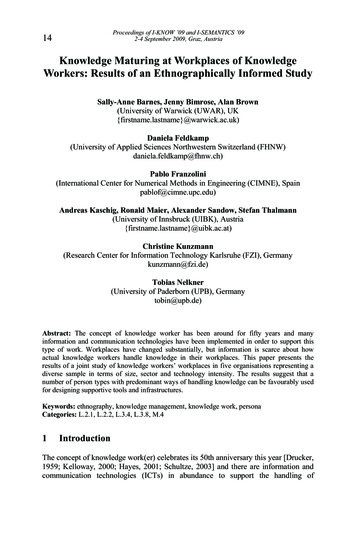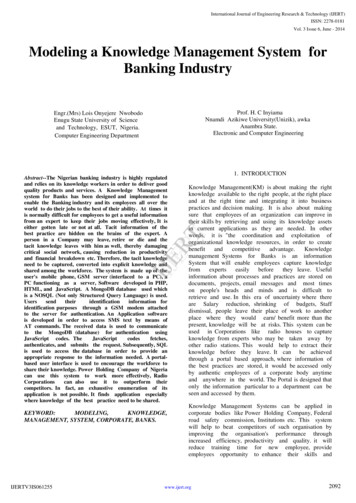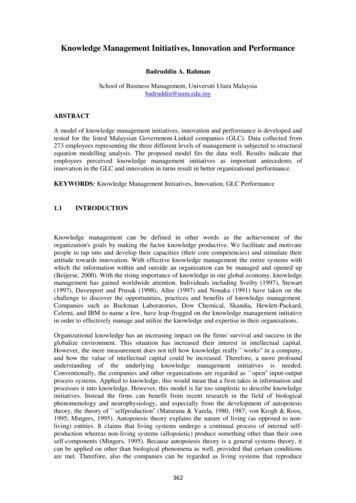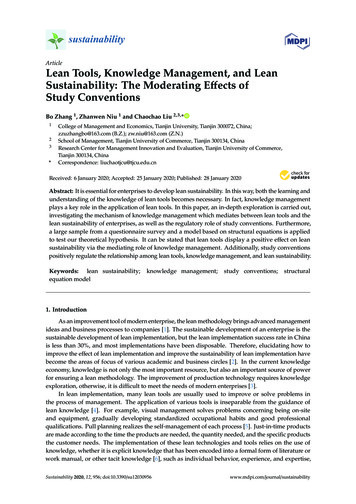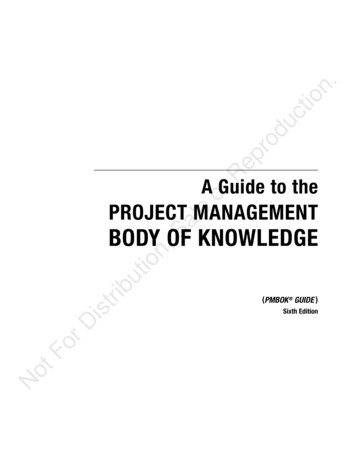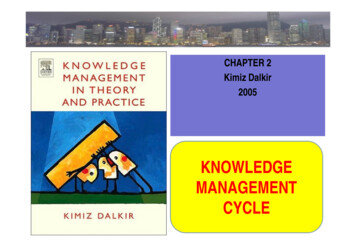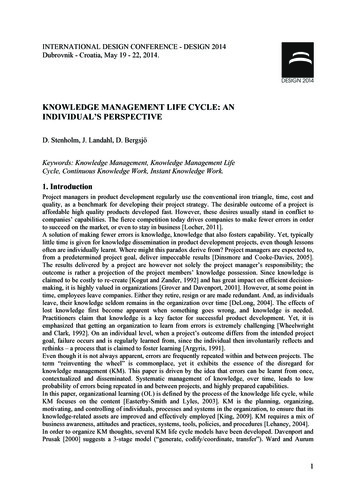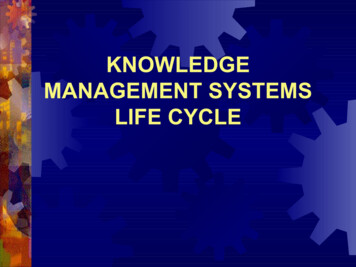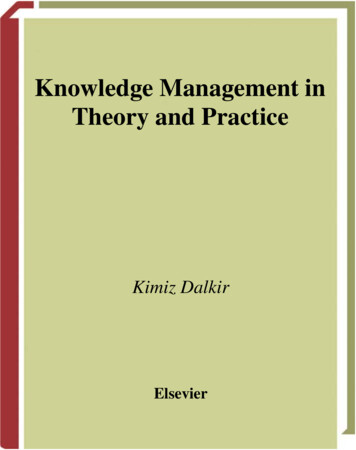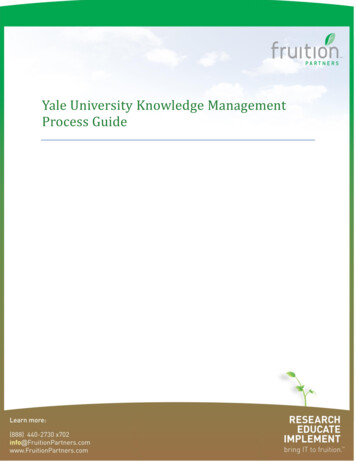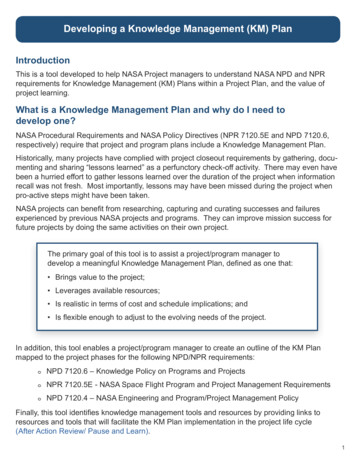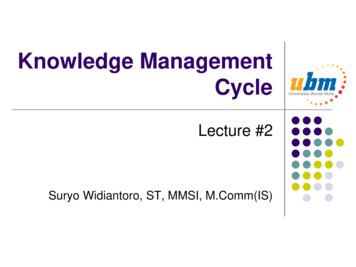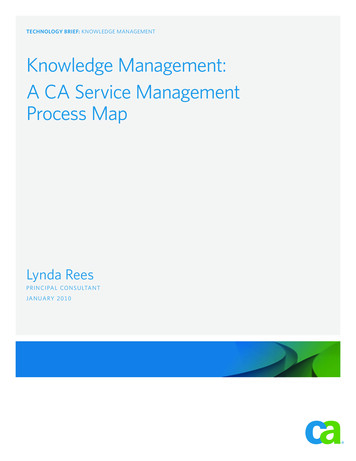
Transcription
TECHNOLOGY brief: KNOWLEDGE MANAGEMENTKnowledge Management:A CA Service ManagementProcess MapLynda ReesPrincipal ConsultantJanuary 2010
Table of ContentsExecutive Summary 1Section 1:Challenge 2Simplifying ITILHow to Use the CA ServiceManagement Process MapsSECTION 2:Opportunity 3The Knowledge Management ProcessCapture InformationThe flow from data to wisdomStoring InformationTransform To Useable KnowledgeTransfer/DisseminateInformed DecisionsIntegrating Knowledge Managementwith other ProcessesOptimizing the KnowledgeManagement JourneySECTION 3:Benefits 9Benefits of KnowledgeManagement Best PracticesSection 4:Conclusions 9Section 5:About the Author 10Copyright 2010 CA. All rights reserved. All trademarks, trade names, service marks and logos referenced herein belong to their respective companies. ITIL is a Registered Trademarkand a Registered Community Trademark of the Office of Government Commerce, and is Registered in the U.S. Patent and Trademark Office. This document is for your informational purposes only. To the extent permitted by applicable law, CA provides this document “As Is” without warranty of any kind, including, without limitation, any implied warranties ofmerchantability or fitness for a particular purpose, or non-infringement. In no event will CA be liable for any loss or damage, direct or indirect, from the use of this document including,without limitation, lost profits, business interruption, goodwill or lost data, even if CA is expressly advised of such damages.
Executive SummaryChallengeThe Information Technology Infrastructure Library version 3 (ITIL V3) process frameworkapproaches IT Service Management (ITSM) from the lifecycle of a service. ITIL V3 bestpractice guidelines are complex and challenging to interpret across all five phases ofthe service lifecycle. Moreover, they are not designed to provide definitive advice aboutimplementing ITSM processes. Many IT organizations consequently undertake an ITILjourney without a firm idea of their goals or path toward achieving said goals.Although most organizations have vast amounts of knowledge across the enterprise—inthe form of individual expertise and data—it may not be easy to query or find. KnowledgeManagement provides a framework to transform data into useable knowledge thatsupports the service lifecycle.OpportunityBy implementing Knowledge Management, you have the opportunity to improve thequality of service delivered to your customers, increase customer satisfaction, and reducethe cost of maintaining and managing services—enabling more informed decision makingthroughout the enterprise.Knowledge Management focuses on ensuring that the right information is delivered tothe right place or person, at the right time, enabling informed and timely decisions. Bytransforming the data in the enterprise into knowledge that is dynamic and context based,other processes within the ITIL framework also benefit.CA has developed a unique approach to charting the ITIL journey through a visualrepresentation of the ITIL framework and its interdependent ITSM processes in the formof a subway map. This map is an ideal starting point for understanding and communicatingabout ITIL. It helps you successfully plan and implement Incident Management programs.BenefitsThe CA Knowledge Management process map enables IT organizations to support services andbetter align IT to business needs. Following the Knowledge Management map helps generate: Improved quality of service and higher user satisfaction Increased adoption of self service Reduced time to diagnose incidents and problems, higher first-call resolutions Reduced training time and costs Faster adoption of new or changed services Increased responsiveness to changing business demandsTECHNOLOGY brief: KN OWLEDGE MANAGEMENT 1
Section 1:ChallengeSimplifying ITILThe ITIL V3 process framework focuses on the service lifecycle and the way that servicemanagement components are structured and linked. It embodies critical guidance for ITorganizations seeking to improve service quality and align more closely with business goals inorder to create value for their business and its customers.But the ITIL V3 best practice guidelines are complex and challenging to interpret across allfive stages of the service lifecycle. Moreover, they are not designed to provide definitive adviceabout implementing ITSM processes. Many IT organizations consequently undertake an ITILjourney without a firm idea of their goals or path toward achieving said goals.CA has developed a unique approach to charting the ITIL journey through a visualrepresentation of the ITIL framework and its interdependent ITSM processes in the form ofa subway map. These maps present an easy-to-navigate, high-level view of the ITIL terrain.IT executives, strategists, and implementers can use these ITSM process maps— along withthe family of CA ITSM Process Map Technology Briefs that expands on them. The maps andtechnology briefs provide a common reference point for understanding and communicatingabout ITIL. They also help you with program planning and implementation.How to Use the CA Service Management Process MapsCA’s ITSM Process Maps use the analogy of subway system maps to illustrate how best tonavigate a continual service improvement journey guided by strategic controls throughoutthe service lifecycle. Each map describes the relevant ITIL processes (tracks) the ITILprocess activities (stations) that you will need to navigate to achieve ITIL process goals (yourdestination), and the integration points (junctions) that you need to consider for processoptimization.CA has developed three maps (Figure A) that portray the critical ITIL disciplines that mostITSM discussions focus on: Service Design, Service Transition, and Service Operation.Figure ACA ITSM PROCESS MAPSThe Service Operations phase of thelifecycle, as shown by the CA ITSMProcess Map for Service Operation(Figure B), is where organizations havetypically begun the ITIL journey—simply addressing the complexities of“keeping the lights on.” Its role in theservice lifecycle has a far-reachingimpact, as its “tracks” are responsiblefor executing processes that optimizethe cost and quality of services.2 TECHNOLOGY brief: KN OWLEDGE MANAGEMENT
SERVICE OPERATIONS MAPService OperationIncidentManagementSecureService AccessPrevent andEliminateProblemsMonitor / TrackRaise EventManagementRecordDService Request(Incl. Self-Service)ExecutivePolicyErrorControlCHService PortfolioManagementFilter /CorrelateTransfer/DisseminateTransformto d ControlAccess RequestInvestigateStore ADemandManagementAccessManagementDetect(Incl. Fault Detection)Select ResponseKProvideRightsOECThis map depicts the major ITILprocesses as the stations en routeto an organizational process or goal(destination). The ITIL processstations are served by tracks, whichare positioned relative to one anotherto illustrate how they support the goalof continuous improvement. The ITILcontinuous improvement cycle takesthe form of a circle or central line, witheach Plan-Do-Check-Act (P-D-C-A)step as a process integration pointor junction on the line. Junctionsserve both as reference points whenassessing process maturity and as ameans to consider the implications ofimplementing a process in isolation.CTFigure BEscalateProblemManagementKnownErrorsCapture Info.Approval(Financial, dServicesProblem ManagementIncident ManagementEvent ManagementKey IntersectionsStrategic ControlsRequest FulfillmentStrategic InputsKnowledge ManagementContinual ServiceImprovementAccess nagementThis paper is part of a series of ITSM Process Map Technology Briefs. Each technology briefexplains how to navigate a particular ITIL process journey, reviewing each process activity thatmust be addressed to achieve process goals. Along each journey, careful attention is paid tohow technology plays a critical role in both integrating ITIL processes and automating ITIL.SECTION 2:OpportunityThe Knowledge Management ProcessThe purpose of Knowledge Management is to provide the right information to the right peopleat the right time to enable informed decision making. Informed decision making enablesservice providers to be more efficient and improve the quality of service delivered.In order to provide this information, context-driven knowledge needs to be created. A ServiceKnowledge Management System (SKMS) becomes the single system to both manage andaccess this information. The Configuration Management System (CMS), ConfigurationManagement Database (CMDB), other data repositories in the enterprise, and the experienceof staff all underpin the SKMS. Data goes through a transformation process before it trulybecomes useful knowledge. Data is captured, stored, analyzed, transformed into informationthat is useful, and made available for use.TECHNOLOGY brief: KN OWLEDGE MANAGEMENT 3
The SKMS is not intended to be one physical database, rather a virtual database able to accessvarious data sources that exist in the enterprise, transform them for use, and present them tothe right audience at the right time. The idea behind the SKMS is similar to that of the CMDB;the data comes from various places such as the CMDB, CMS, Availability Management data,human resource data, Service Portfolio data, supplier and contracts, and any unstructureddata. So, in essence, the SKMS is a federated database, relating all of these pieces andproviding the information needed to manage the full lifecycle of the IT service.ITIL v3 introduced the concept of capturing information throughout the entire service lifecycle.But while information is captured throughout the lifecycle, the transition phase acts as thegateway for knowledge to be introduced into the production environment. Service Transitionuses information from Service Design, such as configuration baselines, and updates the CMDBand thus the CMS. In addition, valuable information is captured during development and testing,and eventually goes through Change Management controls. This phase ensures that the rightknowledge is in place to equip Service Operation.To provide a practical example of Knowledge Management embedded in an ITIL process, thispaper will demonstrate its relationship with Incident Management—as a capturing mechanismand data source. For the purpose of this paper, Knowledge Management is addressed in theService Operation set in the subway map.Knowledge Management is a lifecycle-wide process and has key intersections with other ITILprocesses, such as Incident and Problem Management. For instance, Incident Management isdependent on useful information to enable timely handling of incidents, and contributes to theSKMS by providing workaround information.When addressing Knowledge Management from a Service Operations perspective, the majoractivities include: Capture Information Store Information Transform to Usable Knowledge Transfer/Disseminate Make Informed Decisions4 TECHNOLOGY brief: KN OWLEDGE MANAGEMENT
THE KNOWLEDGE MANAGEMENT eTransformto UsableKnowledgeAANStore Info.PLFigure C illustrates the KnowledgeManagement process line on the CAService Operation subway map, whichserves as a basis for the discussion tofollow.CTFigure CCapture Info.KnowledgeManagementCapture InformationITIL describes the Data-to-Information-to-Knowledge-to-Wisdom (DIKW) structure, whereinformation is captured, stored, analyzed, and transformed into useable knowledge beforeit is transferred for use. Knowledge is built from data, but data has little meaning by itself.To provide meaning, some kind of relationship or context needs to be put around the data totransform it for use in order to put it to action.The flow from data to wisdomAs all knowledge starts with data, an organization can take advantage of the data capturedfrom the various IT Systems. For instance, the first station on the Knowledge Managementjourney is ‘Capture Information’. During this stage, information is captured from processeswithin the ITIL framework (as depicted in the ACT junction on the Incident Managementtrack). During the Incident Management ‘Workaround’ activity, information is captured andrecorded in context to the user, affecting Configuration Item (CI) and all workaround detail.All of this information provides a foundation for putting this into relevant context during thenext stages of Knowledge Management. Problem Management also intersects with IncidentManagement at this stage and provides information on any known errors in the environment.The workaround may be required until a permanent fix has been determined by ProblemManagement, or it could become the permanent fix if the resolution is deemed too costly toimplement. For this purpose, the workaround will then need to move through the next stage ofthe Knowledge lifecycle in order for the organization to use it.Storing InformationAt this stage the Analyst creates, in context, a ‘draft’ knowledge artifact directly from theIncident or Problem. Information is captured and stored from the Incident or Problem record,TECHNOLOGY brief: KN OWLEDGE MANAGEMENT 5
ManagementSecureService AccessPrevent andEliminateProblemsMonitor / TrackRaise including the effected end user, detail andRecordsummary information, the workaround detail,affected CI, and links to any other information. Ideally, this artifact is stored in a centralrepository for the next phase of the process to take place.ExecutivePolicyCHService PortfolioManagementFilter /CorrelateTransfer/DisseminateTransformto d ControlAccess RequestInvestigateStore entPLAc
this map depicts the major itiL processes as the stations en route to an organizational process or goal (destination). the itiL process stations are served by tracks, which are positioned relative to one another to illustrate how they support the goal of continuous improvement. the itiL
